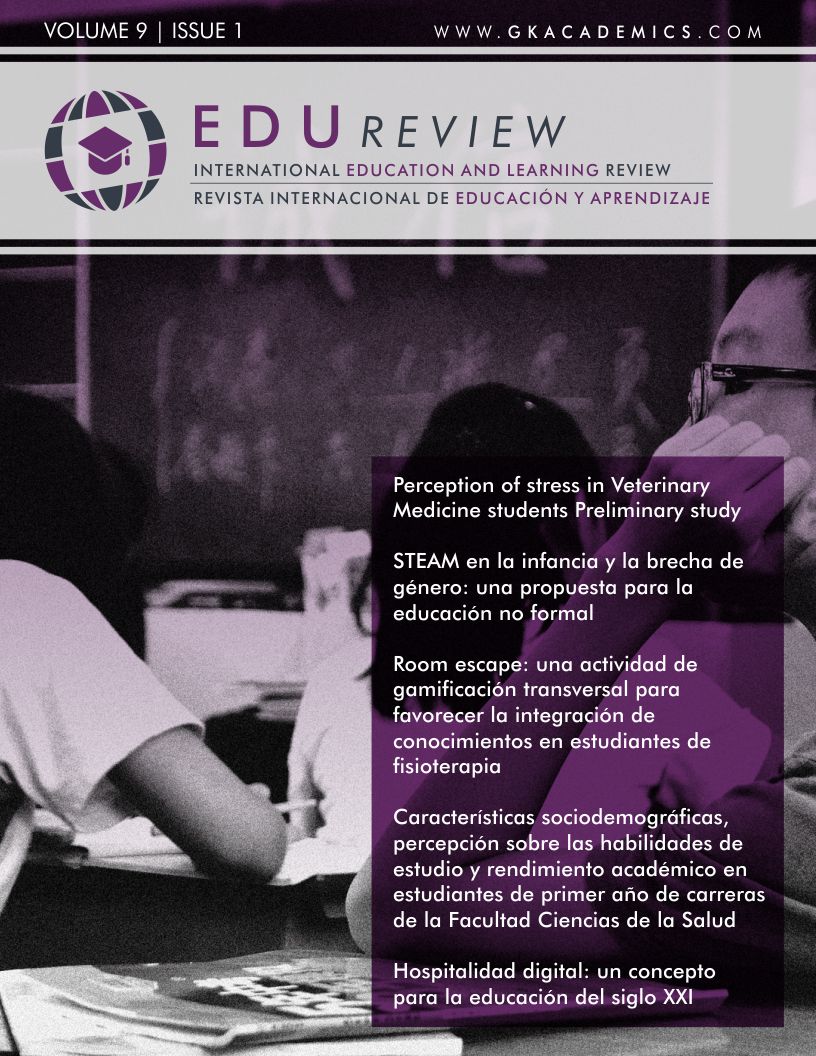Room escape: una actividad de gamificación transversal para favorecer la integración de conocimientos en estudiantes de fisioterapia
DOI:
https://doi.org/10.37467/gka-revedu.v9.2532Palabras clave:
gamificación, fisioterapia, integración, transversal, motivación, Aprendizaje basado en problemas, Escape room, Colaboración, Pensamiento crítico, Motivación, TransversalResumen
Room Escape es un juego de equipo colaborativo en el que se deben resolver casos clínicos, con el objetivo de encontrar el tratamiento adecuado para cada caso. Se pretendió facilitar la integración de contenidos en un entorno de juego y evaluar la percepción de los estudiantes. La actividad se realizó durante dos cursos académicos. Se evaluó de forma cuantitativa y cualitativa a través de un cuestionario. Los estudiantes valoraron positivamente la actividad destacando su utilidad para la integración de contenidos, la posibilidad de autoevaluación, y el fomento del trabajo en equipo de forma dinámica y divertida.
Descargas
Estadísticas globales ℹ️
|
620
Visualizaciones
|
477
Descargas
|
|
1097
Total
|
|
Citas
Albrecht, C.S. (2012). Gamification of positive activity interventions. Maastricht University. The game of apiñes. Maastricht, Países Bajos.
Borrego, C., Fernández, C., Blanes, I. & Robles, S. (2017). Room escape at class: escape games activities to facilitate the motivation and learning in computer science. Journal of Technology and Science Education, 7(2), pp. 162-171. DOI: https://doi.org/10.3926/jotse.247
Bruder, P. (2015). Game on: Gamification in the classroom. The Education Digest, 3, pp. 56-60.
Corchuelo-Rodríguez, C.A. (2018). Gamificación en educación superior: experiencia innovadora para motivar estudiantes y dinamizar contenidos en el aula. Edutec. Revista Electrónica de Tecnología Educativa, 63. DOI: https://doi.org/10.21556/edutec.2018.63.927
Csikszentmihályi, M. (1975). Beyond boredom and anxiety, San Francisco: Jossey-Bass.
Ermi, L., & Mäyrä, F. (2005). Player-Centred Game Design: Experiences in Using Scenario Study to Inform Mobile Game Design. Game Studies, 5(1).
Esteban, M. (2008). Uso de problemáticas éticas para la enseñanza del código deontológico de la psicología. Una sesión ilustrativa. Revista de Enseñanza de la Psicología: Teoría y Experiencia, 4, pp. 14-20.
Esteban, M. (2009a). Bases psicopedagógicas del Aprendizaje Basado en Problemas (ABP). El cruce de caminos entre Vygotski y Piaget. Boletín de Educación, 40, pp. 39-48.
Esteban, M. (2009b). Un estudio empírico sobre las ventajas e inconvenientes del Aprendizaje Basado en Problemas (ABP) en grupos numerosos. Aprender. Cuaderno de Filosofía y Psicología de la Educación, 7, pp. 131-145.
Esteban, M. (2009c). Las ideas pedagógicas de Bruner. De la revolución cognitiva a la revolución cultural. Educación. Revista Venezolana de Educación, 13, pp. 235-241.
Esteban, M. (2009d). La dimension ética de la práctica profesional: Evaluación de un programa formativo. Diálogo Educacional, 9, pp. 91-101. DOI: https://doi.org/10.7213/rde.v9i26.3670
Eukel, H.N., Frenzel, J.E. & Cernusca, D. (2017). Educational Gaming for Pharmacy Students – Design and Evaluation of a Diabetes-themed Escape Room, American Journal of Pharmaceutical Education, 81 (7), pp. 6265. DOI: https://doi.org/10.5688/ajpe8176265
Foncubierta, J.M. & Rodríguez, C. (2014). Didáctica de la gamificación en la clase de español. Editorial Edinumen.
Hamari, J. & Jonna, K. (2013). Social motivations to use gamification: an empirical study of gamifiyng exercise. ECIS, 105.
Jambhekar, K., Pahls, R.P. & Deloney, L.A. (2020). Benefits of an Escape Room as a Novel Educational Activity for Radiology Residents. Academic Radiology, 27(2), pp. 276-283. DOI: https://doi.org/10.1016/j.acra.2019.04.021
Lee, J., Ceyhan, P., Jordan-Cooley, W. & Sung, W. (2013). GREENIFY: A Real-World Action Game for Climate Change Education. Simulation & Gaming, 44(2–3), pp. 349–365. DOI: https://doi.org/10.1177/1046878112470539
Lee, J. & Hammer, J. (2011). Gamification in education: What, how, why bother? Academic Exchange Quarterly, 15(2), pp. 146–1151.
Malteraud, K. (2012). Systematic text condensation: A strategy for qualitative analysis. Scandinavian Journal of Public Health, 40, pp. 795-805. DOI: https://doi.org/10.1177/1403494812465030
Martin, A.A., Díaz, D., Monserrat, S. & Reyes, E. (2014). Experiencias de aplicación de estrategias de gamificación a entornos de aprendizaje universitario, ReVisión, 7(2).
Portney, L.G. & Watkins, M.P. (2009). Foundations of Clinical Research. Applications to Practice. 3rd edition. Upper Saddle River. New York: Prentice Hall Health.
Prensky, M. (2010). Digital natives, digital immigrants- A new way to look at ourselves and our kids. Cuadernos SEK 2.0, Institución Educativa SEK, Distribuidora SEK, S.A, pp. 1-21.
Sierra-Daza, M.C. & Fernández-Sánchez, M.R. (2019). Gamificando el aula universitaria. Análisis de una experiencia de Escape Room en educación superior. Revista de Estudios y Experiencias en Educación, 18(36), pp. 105-115. DOI: https://doi.org/10.21703/rexe.20191836sierra15
Werbach, K. & Hunter, D. (2015). The Gamification Toolkit: Dynamics, Mechanics, and Components for the Win. Wharton Digital Press.
Zepeda-Hernández, S., Abascal-Mena, R. & López-Ornelas, E. (2016). Integración de gamificación y aprendizaje activo en el aula. Revista Ra Ximhai, 12(6), pp. 315-325. DOI: https://doi.org/10.35197/rx.12.01.e3.2016.21.sz
Zhang, X., Diemer, G., Lee, H., et al. (2019). Finding the ‘QR’ to Patient Safety: Applying Gamification to Incorporate Patient Safety Priorities Through a Simulated ‘Escape Room’ Experience. Cureus, 11(2), e4014. DOI: https://doi.org/10.7759/cureus.4014
Descargas
Publicado
Cómo citar
Número
Sección
Licencia
Los autores/as que publiquen en esta revista aceptan las siguientes condiciones:
- Los autores/as conservan los derechos de autor.
- Los autores/as ceden a la revista el derecho de la primera publicación. La revista también posee los derechos de edición.
- Todos los contenidos publicados se regulan mediante una Licencia Atribución/Reconocimiento-SinDerivados 4.0 Internacional. Acceda a la versión informativa y texto legal de la licencia. En virtud de ello, se permite a terceros utilizar lo publicado siempre que mencionen la autoría del trabajo y a la primera publicación en esta revista. Si transforma el material, no podrá distribuir el trabajo modificado.
- Los autores/as pueden realizar otros acuerdos contractuales independientes y adicionales para la distribución no exclusiva de la versión del artículo publicado en esta revista (p. ej., incluirlo en un repositorio institucional o publicarlo en un libro) siempre que indiquen claramente que el trabajo se publicó por primera vez en esta revista.
- Se permite y recomienda a los autores/as a publicar su trabajo en Internet (por ejemplo en páginas institucionales o personales), una vez publicado en la revista y citando a la misma ya que puede conducir a intercambios productivos y a una mayor y más rápida difusión del trabajo publicado (vea The Effect of Open Access).













